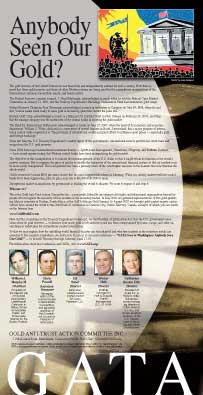You are here
Murphy''s ''Midas'' commentary for May 6: ''They just don''t get it''
11:53p ET Monday, May 8, 2006
Dear Friend of GATA and Gold:
The story about market manipulation appended here,
from Sunday's New York Times, was brought to your
attention by GATA last November when the Chicago
Sun-Times reported it:
http://groups.yahoo.com/group/gata/message/3422
CHRIS POWELL, Secretary/Treasurer
Gold Anti-Trust Action Committee Inc.
* * *
The Mystery of the Stock Price and the Strike Price
By Mark Hulburt
The New York Times
Sunday, May 7, 2006
http://www.nytimes.com/2006/05/07/business/yourmoney/07stra.html?
_r=2&oref=slogin&oref=
So many options traders lose money that they have grown to suspect
they are not operating on a level playing field. A recent academic
study provides them with some potentially powerful ammunition.
The study, "Stock Price Clustering on Option Expiration Dates,"
appeared last October in The Journal of Financial Economics. Its
authors are Neil D. Pearson and Allen M. Poteshman, both finance
professors at the University of Illinois, and Sophie Xiaoyan Ni, a
Ph.D. student there. A version is at:
http://papers.ssrn.com/sol3/papers.cfm?abstract-id=519044.
The researchers focused on unusual trading patterns of stocks when
options on them were expiring. They found an increased likelihood
that a stock would close on the options expiration day at or very
near the strike price of one of its expiring options.
A strike price, of course, is the price at which an option's owner
can buy the underlying stock (if the option is a call) or sell the
stock (if the option is a put). A stock typically has options with
many different strike prices, set at regular intervals every $5,
for example. Options also vary by month of expiration; all of a
given month's options expire on the third Friday.
In effect, the researchers found that the closing prices of stocks
that have options were not randomly distributed on expiration days,
but instead tended to cluster around the strike prices of certain of
their options.
Consider how often a stock closes within 12.5 cents of one of its
option's strike prices. On all days other than the expiration date,
the researchers found, this happens about 10.5 percent of the time.
But on option expiration days, this frequency jumps a full
percentage point, to around 11.5 percent. That suggests that option
strike prices are acting like magnets, drawing stock prices toward
them.
This clustering may not seem a big deal, but the researchers say
they are confident that it can't be attributed to chance. And the
dollars involved are substantial. Some investors' portfolios will
increase in value on the expiration day because of the clustering,
while others' portfolios will suffer. The researchers estimate that
for the average option expiration day from 1996 through 2002, these
portfolio shifts totaled at least $9.1 billion. On an annual basis,
this amounts to more than $100 billion.
Could the cause of this clustering have nothing to do with options
expiration? The researchers believe not, since they were unable to
find a similar pattern among stocks for which no options exist. They
also examined what happened to these stocks when and if options
began to be traded on them. They found that clustering generally
appeared almost immediately in these stocks' trading patterns on
expiration days.
This clustering does not automatically mean that these stocks are
being manipulated, the researchers say. It could also be caused by
straightforward hedging transactions that are regularly undertaken
by market makers on options exchanges. Marty Kearney, senior
instructor at the Options Institute, the educational arm of the
Chicago Board Options Exchange, said he believes that these market
makers' hedges cause the bulk of any price clustering on options
expiration day.
The study's authors don't disagree that market makers play a large
role. But they found that the market makers' activities could not
fully explain the clustering. They say it is likely that
manipulation is also taking place.
Who would have an incentive to manipulate stocks this way? One group
would be those who sell options short, known as option writers.
Traders in this group in effect are betting that the options'
underlying stocks will rise (in the case of puts they have sold
short) or fall (in the case of calls). They could lose big if these
stocks move too far in the wrong direction.
You would need to be a very wealthy investor indeed to be able to
buy or sell enough shares of a stock to move its price in a given
direction. But the researchers believe that some would qualify. They
focused special attention on a group known as firm proprietary
traders, which includes employees of large investment banks who are
trading options for those banks' accounts. The researchers argue
that these traders would be in a position to manipulate stock prices
by selling large numbers of shares whose prices they wanted to keep
from rising and by buying other shares whose prices they wanted to
support.
The researchers say that it is impossible to identify any particular
firm that may have engaged in manipulation because they had access
only to aggregate data for firm proprietary traders as a whole.
Even if they did have data for individual firms, it would still be
hard to prove that any one of them specifically engaged in
deliberate stock manipulation, which would be illegal. Such proof
would depend on demonstrating what the firm's traders were intending
to do when buying or selling stocks on expiration day. And there is
no shortage of plausible explanations that those traders could
provide for their behavior.
In an interview, Lawrence E. Harris, a former chief economist at the
Securities and Exchange Commission and now a finance professor at
the University of Southern California, says the difficulty in
proving manipulation is probably an inherent feature of modern
markets. "Because the markets are so complex," he said, "it is
relatively easy for traders engaged in manipulation to offer
alternative explanations for their behavior that would make it
difficult to successfully prosecute them."
Professor Harris nonetheless said that "when presented with the data
suggesting manipulation by firm proprietary traders, it's reasonable
to expect that the S.E.C. would consider investigating the matter
further." The S.E.C. had no comment on the researchers' study.
At least two major lessons can be drawn from the study, according to
Professor Harris. First, he said, "there are limits to what the
S.E.C. can do to protect you from the actions of clever traders who
arrange their trades to put you at a disadvantage." The second, he
said, is this: "Unsophisticated traders should be wary of trading
options."
--------------
Mark Hulbert is editor of The Hulbert Financial Digest, a service of
CBSMarketWatch.
----------------------------------------------------
To subscribe to GATA's dispatches, send an e-mail to:
gata-subscribe@yahoogroups.com
To unsubscribe, send an e-mail to:
gata-unsubscribe@yahoogroups.com
Caution: America Online prohibits delivery of GATA
dispatches to AOL e-mailboxes.
----------------------------------------------------
RECOMMENDED INTERNET SITES
FOR DAILY MONITORING OF GOLD
AND PRECIOUS METALS
NEWS AND ANALYSIS
Free sites:
http://www.cbs.marketwatch.com
http://www.usagold.com/amk/usagoldmarketupdate.html
http://www.capitalupdates.com/
http://www.silver-investor.com
http://www.thebulliondesk.com/
http://www.goldismoney.info/index.html
http://www.minersmanual.com/minernews.html
http://www.a1-guide-to-gold-investments.com/euro-vs-dollar.html
http://www.investmentrarities.com
http://www.kereport.com
(Korelin Business Report -- audio)
http://www.plata.com.mx/plata/home.htm
(In Spanish)
http://www.plata.com.mx/plata/plata/english.htm
(In English)
http://www.resourceinvestor.com
http://www.goldpennystocks.com/
Subscription sites:
http://www.lemetropolecafe.com/
http://www.interventionalanalysis.com
http://www.investmentindicators.com/
Eagle Ranch discussion site:
http://os2eagle.net/checksum.htm
Ted Butler silver commentary archive:
http://www.investmentrarities.com/
----------------------------------------------------
COIN AND PRECIOUS METALS DEALERS
WHO HAVE SUPPORTED GATA
AND BEEN RECOMMENDED
BY OUR MEMBERS
Blanchard & Co. Inc.
909 Poydras St., Suite 1900
New Orleans, Louisiana 70112
888-413-4653
http://www.blanchardonline.com
Centennial Precious Metals
Box 460009
Denver, Colorado 80246-0009
1-800-869-5115
http://www.USAGOLD.com
Michael Kosares, Proprietor
cpm@usagold.com
Colorado Gold
222 South 5th St.
Montrose, Colorado 81401
http://www.ColoradoGold.com
Don Stott, Proprietor
1-888-786-8822
Gold@gwe.net
El Dorado Discount Gold
Box 11296
Glendale, Arizona 85316
http://www.eldoradogold.net
Harvey Gordin, President
Office: 623-434-3322
Mobile: 602-228-8203
harvey@eldoradogold.net
Gold & Silver Investments Ltd.
Mespil House
37 Adelaide Rd
Dublin 2
Ireland
+353 1 2315260/6
Fax: +353 1 2315202
http://www.goldinvestments.org
info@gold.ie
Investment Rarities Inc.
7850 Metro Parkway
Minneapolis, Minnesota 55425
http://www.gloomdoom.com
Greg Westgaard, Sales Manager
1-800-328-1860, Ext. 8889
gwestgaard@investmentrarities.com
Kitco
178 West Service Road
Champlain, N.Y. 12919
Toll Free:1-877-775-4826
Fax: 518-298-3457
and
620 Cathcart, Suite 900
Montreal, Quebec H3B 1M1
Canada
Toll-free:1-800-363-7053
Fax: 514-875-6484
http://www.kitco.com
Lee Certified Coins
P.O. Box 1045
454 Daniel Webster Highway
Merrimack, New Hampshire 03054
http://www.certifiedcoins.com
Ed Lee, Proprietor
1-800-835-6000
leecoins@aol.com
Lone Star Silver Exchange
1702 S. Highway 121
Suite 607-111
Lewisville, Texas 75067
214-632-8869
http://www.discountsilverclub.com
MRCS Canada
12303-118 Ave. NW
Edmonton, Alberta T5L 2K2
Canada
http://www.mrcscanada.com
Michael Riedel, Proprietor
1-877-TRY-MRCS
1-877-879-6727
mrcscanada@shaw.ca
Miles Franklin Ltd.
3015 Ottawa Ave. South
St. Louis Park, Minn. 55416
1-800-822-8080 / 952-929-1129
fax: 952-925-0143
http://www.milesfranklin.com
Contacts: David Schectman,
Andy Schectman, and Bob Sichel
Missouri Coin Co.
11742 Manchester Road
St. Louis, MO 63131-4614
info@mocoin.com
314-965-9797
1-800-280-9797
http://www.mocoin.com
Resource Consultants Inc.
6139 South Rural Road
Suite 103
Tempe, Arizona 85283-2929
Pat Gorman, Proprietor
1-800-494-4149, 480-820-5877
Metalguys@aol.com
http://www.buysilvernow.com
Richard Nachbar Rare Coins
5820 Main St., Suite 601
Williamsville, N.Y. 14221-8232
877-622-4227
http://www.CoinExpert.com
nachbar@coinexpert.com
Swiss America Trading Corp.
15018 North Tatum Blvd.
Phoenix, Arizona 85032
http://www.swissamerica.com
Dr. Fred I. Goldstein, Senior Broker
1-800-BUY-COIN
FiGoldstein@swissamerica.com
The Moneychanger
Box 178
Westpoint, Tennessee 38486
http://www.the-moneychanger.com
Franklin Sanders
1-888-218-9226, 931-766-6066
----------------------------------------------------
HOW TO HELP GATA
If you benefit from GATA's dispatches, please
consider making a financial contribution to
GATA. We welcome contributions as follows.
By check:
Gold Anti-Trust Action Committee Inc.
c/o Chris Powell, Secretary/Treasurer
7 Villa Louisa Road
Manchester, CT 06043-7541
USA
By credit card (MasterCard, Visa, and
Discover) over the Internet:
http://www.gata.org/creditcard.html
By GoldMoney:
http://www.GoldMoney.com
Gold Anti-Trust Action Committee Inc.
Holding number 50-08-58-L
Donors of $200 or more will receive copies
of "The ABCs of Gold Investing" by Michael
Kosares, proprietor of Centennial Precious
Metals in Denver, Colorado, and "The Coming
Collapse of the Dollar" by James Turk and
John Rubino.
GATA is a civil rights and educational
organization under the U.S. Internal Revenue
Code and contributions to it are tax-deductible
in the United States.








